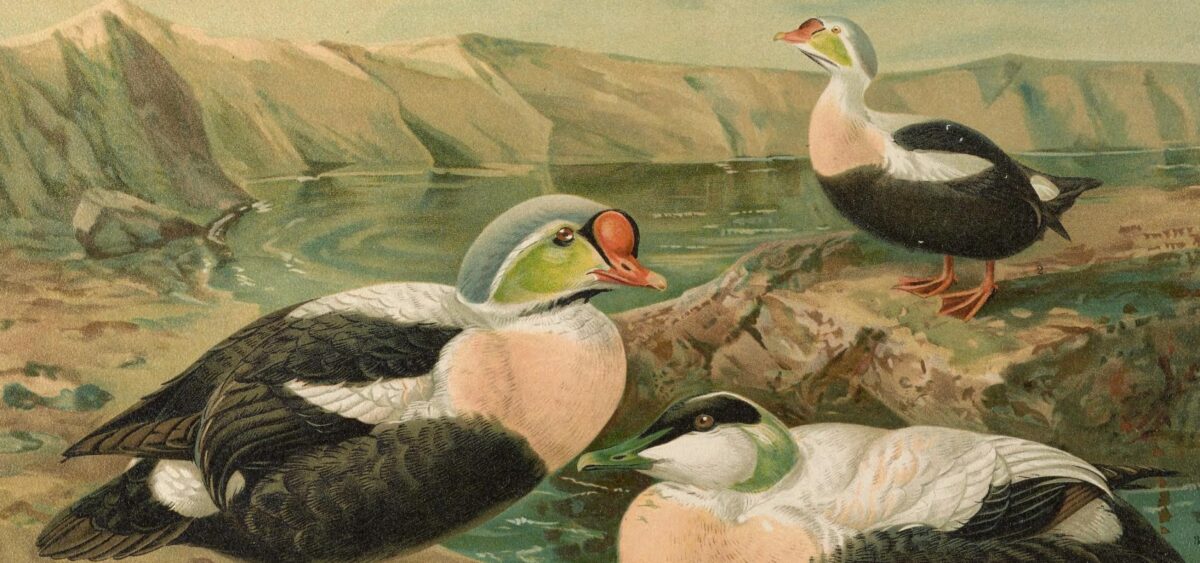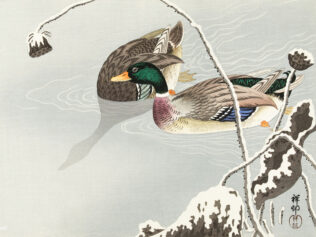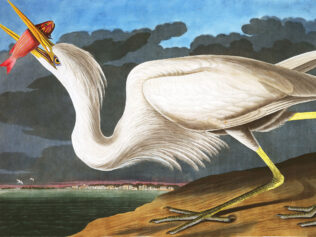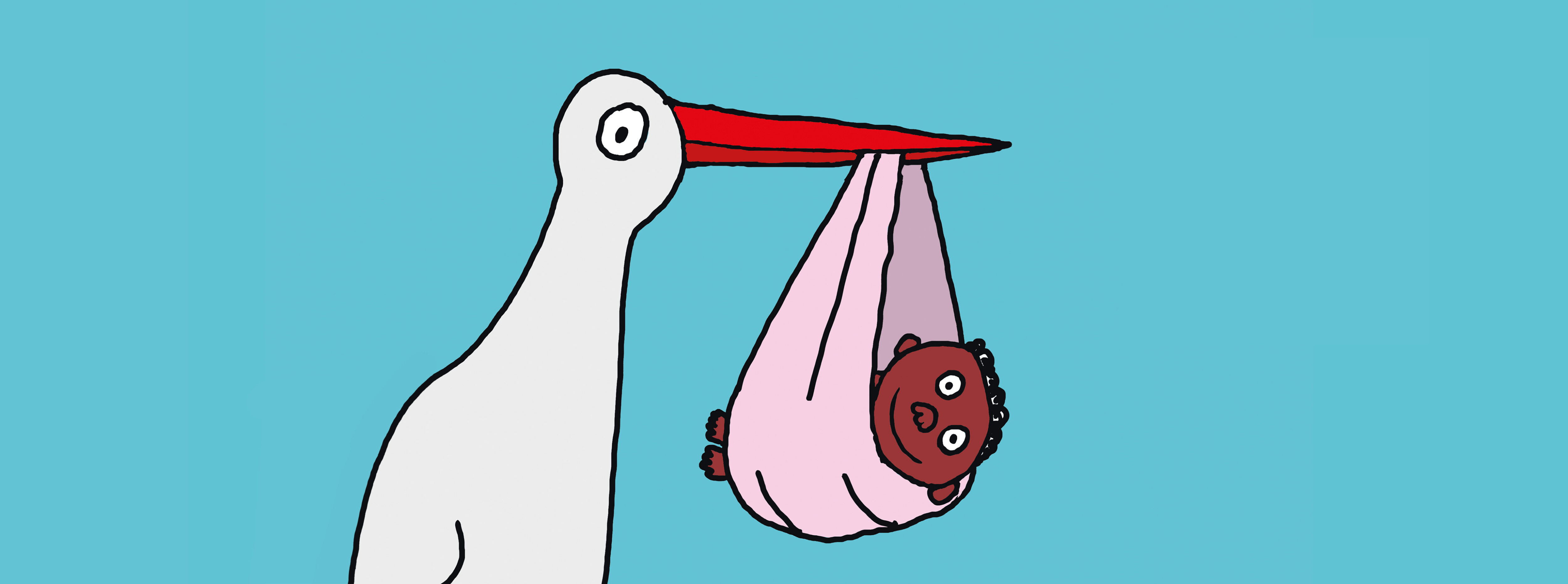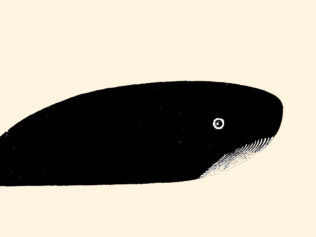
What role does contemporary science play in shaping our perspectives, and is there a place in it for the unfettered curiosity and excitement accompanying the discovery of the unknown? This is a question worth considering when reading about its humanist roots and the story of a certain extraordinarily-colored duck.
One day in 1807, while locked in his lab, Humphry Davy intended to connect one of the terminals of his substantial electrical battery (it has a good few hundred volts enclosed in a layer cake of metal and tissue paper sheets soaked in acid) to his new contraption. At the very center of the device was a small crucible with a crushed white substance heated by a burner placed underneath the vessel. The white powder was potash, or potassium hydroxide—a corrosive chemical compound that melts when exposed to heat, turning into an oily, cloudy liquid. One drop of this boiling concoction can burn out a person’s eye. The scientist, however, ignored the danger. The metal melting pot was already connected to the battery. To start his experiment, Davy only had to plug the cell into the electrode stuck into the boiling potash. When the electrical circuit was closed, something in the crucible made a loud bang, and hissing drops of liquid lye and smoky sparks, burning violet, exploded from under the platinum electrode in every direction. Fortunately, Davy was not harmed, only staring in fascination at the fountain of flames and the destruction, as it meant that his scientific predictions were right. Indeed, the electrolysis of potassium lye led to the production of a highly reactive metallic potassium, a process which Davy meticulously refined in subsequent attempts, until finally obtaining a clean sample of this soft metal for the first time.
For an outside observer such catastrophe would have been an entirely sufficient argument to never again combine high voltage and melted lye in one place. Davy, however, did not stop at potassium. In subsequent months, using an improved version of his device, he extracted pure sodium, strontium, barium, and magnesium—each time maintaining the balance of scientific discovery with the threat of getting maimed for life by an explosion. Davy was driven by a feeling that every scientist probably knows very well. A burning desire to discover the intricate workings of reality.
A Sample of Overwhelming Complexity
Is there still room today—in the era of science pursued in sterile laboratories, among long lists of safety regulations and research funding rules—for unfettered curiosity? A researcher myself, every day I examine a microscopic sample of the world around us; I break it down into even smaller parts, a tiny cross-section of the overwhelming complexity that is the biology of the most diverse life forms. It’s hard not to notice that science has changed from a romantic pursuit of knowledge—the answers to endless questions, the possibility of boundless exploration—into a steady stream of evenly cut, trimmed, and neatly packaged facts. It’s dictated by bibliometric parameters, upon which the researcher’s career depends, as well as access to valuable (see: scarce) research funding. Two centuries of meticulously constructing the mechanism for conducting research, based on reports published in peer-reviewed scientific journals, has created a protocol that codifies everything that happens around a discovery. Therefore, excessive excitement or enthusiasm is in bad taste. Reading scientific work, one gets the impression that a tone of restrained courtesy prevails. It is written in the language of polished diplomacy, constantly searching for the golden mean between announcing a great discovery to the world and signaling the reserve and caution that should always characterize a good scientist—ceaselessly critical and vigilant in their daily quest to discover scientific truth. One day, when my colleague and I were thinking about breaking (or, rather, gently bending) the rigid rules that govern the structure of a typical research paper. I was amazed by the stubbornness of my own mind, formatted throughout years of education, and not allowing such transgressions. Eventually, the article included a quotation—proposed by my co-author, and referenced in the bibliography between strictly scientific positions—a quote from Madonna’s “Don’t Cry for Me Argentina.”
The thinking of researchers’ is made even more inflexible by the extreme fragmentation of science into “micro-challenges.” During the 17th-century scientific revolution, the researcher was a genuine pioneer. Their research overturned ancient world views, grounded the understanding of the laws of physics closest to humans, and revealed the existence of newly-discovered chemical elements. Today some claim that science has discovered everything, and progress means facing ever more precise, ever more isolated problems—issues of such detail and abstraction that they will require a constant narrowing of scientific specializations. As a result, the splendor and beauty of reality as such, everything that propelled the romantic pursuit of the mysteries of the cosmos, will disappear from the horizon of research interests.
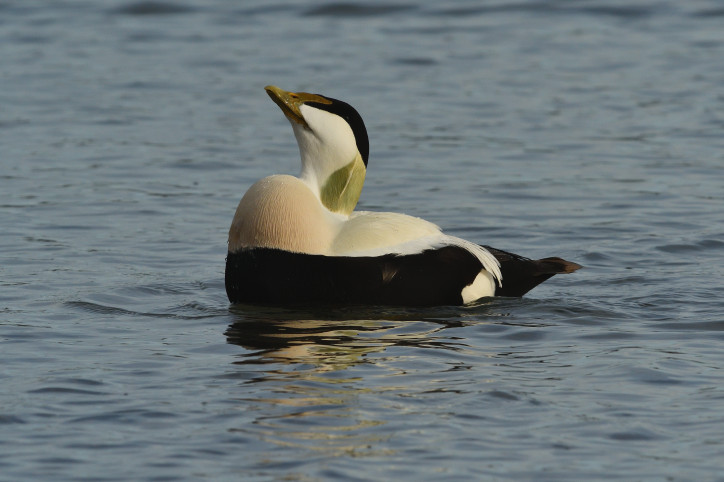
The Duck’s New Clothes
Imagine my surprise when a consuming, almost primal, curiosity crept back into this ordered and staid world. I need to state right away that, as a naturalist, I don’t think I have ever lost the pleasant prick of excitement that accompanies the question, “What if…?” Studying nature has an element of the search for ever-new thrills and challenges—at least, this is how I perceived natural history, as opposed to the more precise, molecular branches of biological sciences. Yet, I gradually succumbed to this tendency, carving out a place for myself in a narrow, specialized field—an area of biology where I could launch my own micro-campaigns, aimed at solving specific problems. In doing so, I avoided large-scale invasions calculated to invalidate theories and paradigms, which are as exciting as they are risky. Then, out of the blue, an eider sea-duck swam into this safe world. Metaphorically, of course. It floated in with my doctoral student, to be exact.
Common eiders are beautiful birds. They belong to the Anatidae family (which includes ducks, geese, and swans). They can be found on the Polish seaside, especially in the winter, but their basic habitat is the Baltic and Atlantic coasts of Scandinavia and the Arctic. The common eider male’s dazzling plumage is positively resplendent—the white dorsum and neck contrast with the black belly and top of the head. The breast is covered in pale pink, blending into beige. Most interesting, however, is the nape. A patch of grayish-green spills over it—either more faded or intensely mossy-hued, depending on the freshness of the coat.
To Be Green
Color is one of the subjects of my research—naturally, the prospect of studying the eider was something very intriguing. We wondered where the amazing shade of green came from. In a flash, it turned into an almost childlike fascination. After browsing through several bird guides and reading analyses of avian colors, we came to the conclusion that the eider was wearing something unique on its neck, even in the context of the colorful variety of birds. It became clear that we had to investigate the mechanism of how this shade had formed. In all the literature on the subject, we found only one old article that showed the spectrum of an eider’s nape—a kind of chart made by sampling a patch of color with photons of various hues and recording how some of them are absorbed by such a spot, while others are reflected. There wasn’t a word on the real way the eider’s green is created. Perhaps a mysterious dye in the bird’s skin is injected in the growing feathers’ barbs. Or maybe the process is connected to so-called “structural color,” the uncolored feather tissue shimmering due to its microscopic structure (a bit like the holographic stickers on credit cards).
What followed in the ensuing weeks was a fascinating marathon of the most marvelous research I have ever dared to indulge in my entire life. Like a detective story, my partner and I attempted to solve the mystery of the eider’s feathers. (By a stroke of luck, an adult male fell into our hands; he lost his life on the rocks of Sweden’s Gotland during a storm, and we happened to be visiting the island in connection with other research). Therefore, we did everything our biological instruments allowed us to. We ground the feathers in a ball mill and in a mortar with fuming liquid nitrogen. We boiled them in a variety of concoctions, hoping to induce the mysterious pigment to come out of the feather’s tissue and reveal its identity. We also cut feather scraps into very thin slices, and X-rayed them with superfast electrons in order to sample the various atoms that might be lurking in the coils and folds of the bird’s keratin, and to have a peek into the nanoscale nooks and crannies of the feathery structure.
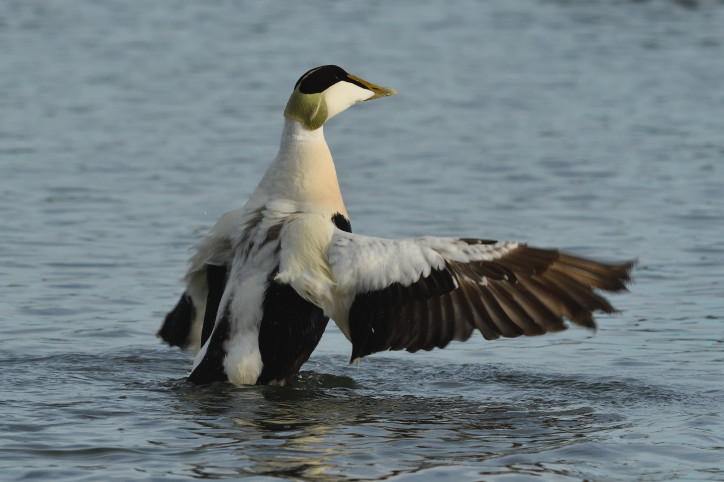
Science on a Leash
Despite our many efforts, the common eider greenness remained a mystery. We failed to unambiguously identify its source. Although, I must say, that electron bombardment of the celadon tissue has led us to a clue: the possibility that there might be a pigment in the eider’s feathers that contains copper atoms in its molecules. The quest for the Green Fleece—temporarily suspended because of COVID-19—continues. And I can’t get over one thing: that all this excitement, investigative passion, emotional deliberation over possible scenarios, will not be included in a potential publication; that, once again, the effect will be a dry, precise, exact exposition of our hypotheses, methods, and results. Because it is “not becoming” of scientists. Besides, it is not unlikely that any attempt at such a “relaxed” narrative of a scientific work would be torpedoed by an editor or a reviewer during the submission process.
Yet, I would suggest that this is precisely the path that science should take. The importance of curiosity and unfettered creativity is often emphasized. It is invoked by editors of scientific journals, professors greeting new students, university presidents and deans, by successive ministers of science and research. After which, everyone, including students, return to the rigid rulebook of scientific reports and the painfully boring schemas of research papers—with astounding unamity. But scientists are not robots. They are human beings, who have doubts and are emotional about their work. They experience euphoria when discovering something new, or frustration when a hypothesis cannot be verified. Showing researchers from a different side—foregrounding their emotions and innate curiosity that evolve with the scientific process; how they are motivated by subsequent steps, and what decisions they can make because of them—would once again give a more human face to the discipline. Perhaps we would even be more inclined to trust such science, practiced by ordinary people and not by oracles and guardians of the sacred fire of knowledge.
There is also a risk that scientific results communicated in such a way would be used to disreputable ends. It takes a lot of attention, sensitivity, and consistency not to trivialize the emotional, humanist side of science; to avoid twisting its meaning and role in the process of discovering reality. It’s not impossible, though, and—if carried out cautiously—it could perhaps remedy the lack of trust in science, which is increasingly affecting key spheres of our lives, such as public health, nature conservation, or energy transition. In ancient times and during the Renaissance, investigating reality had a deeply humanist value. Perhaps, the next scientific revolution will return to these freethinking roots.

Translated from the Polish by Adam Zdrodowski


